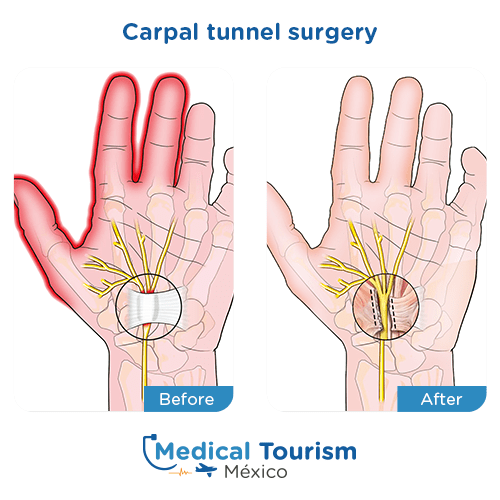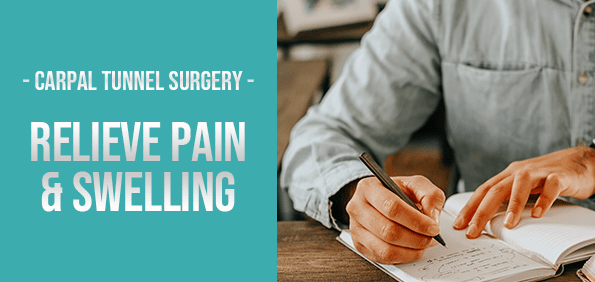The most reliable doctors in Mexico
Carpal tunnel surgery information and locations in Mexico
Carpal tunnel surgery helps relieve pressure from the median nerve and reduce the symptoms of
carpal tunnel syndrome. This surgery can improve the patient’s movement and control over their
hands.
Carpal tunnel syndrome develops when the passage in the wrist narrows or surrounded tissues
swell, putting pressure on the median nerve. During the procedure, neurosurgeons cut the
transverse carpal ligament to give more space and alleviate the pressure on the nerve; the
ligaments will grow back together while leaving the extra space created. There are two
techniques used for this surgery, both can be done under local or general anesthesia.
Surgical approach for carpal tunnel
Open surgery
A 2-inch incision is made on the wrist and palm, where the surgeon will access the
transverse carpal ligament.
Endoscopic surgery
One or two small incisions are made on the wrists, then the surgeon will introduce a
camera and the required tools to work on the ligament.
Get a carpal tunnel surgery with the best neurosurgeons in Mexico!
Benefits
Relieves pain and swelling
Restores muscle strength
Can improve mobility
Minimal downtime
Restores muscle strength
Can improve mobility
Minimal downtime
Carpal tunnel surgery
Procedure:
30 min.
Hospital stay: 15 - 30 min.
Cleared to fly: 1 day
Hospital stay: 15 - 30 min.
Cleared to fly: 1 day
After surgery
Out of town patients’ follow-ups can be scheduled with the neurosurgeon face-to-face or virtually. Patients are
clear for flying after 1 day from carpal tunnel surgery.
Note: Follow-ups can be arranged as face-to-face or virtually. If needed, you can go to your primary care physician to remove sutures or get medication adjustments.
As an Amazon Associate, we earn from qualifying purchases.
Take a look at one of our medical tourism essentials for neurosurgery.
Take a look at one of our medical tourism essentials for neurosurgery.
Before and after images
View additional images for this procedure.

View more


Locations
Select the city of your choice to seethe doctors profile.
Guadalajara, Jal.
Dr. Óscar Gutiérrez
View more

Carpal tunnel surgery frequent questions
Get answers to our most frequently asked questions and what to expect after the procedure.
Am I a candidate for carpal tunnel surgery?
Candidates for this procedure have already received a diagnosis of carpal tunnel syndrome, and prior non-surgical treatments have failed to relieve their symptoms. To find out if you are a candidate for the procedure, we suggest you consult one of our qualified doctors.
How do I prepare for carpal tunnel surgery?
Carpal tunnel surgery requires similar preparations to other treatments, like avoiding smoking, and stopping eating and drinking 12 hours before the surgery starts. Your doctor might also ask you to stop taking certain medications.
Do I need open or endoscopic surgery?
The ideal technique for this kind of procedure is endoscopic surgery since it can result in faster healing and fewer scars, but some patients with more pronounced carpal tunnel symptoms might require open surgery because it gives the doctor more room to perform the procedure.
How do I care for my hand after the surgery?
Your doctor will place a bandage on your wrist that needs to stay there for 1 or 2 weeks, in addition to giving you a set of exercises that will help you recover your strength. You will also be instructed to place an ice pack on your hand 3 or 4 times per day and to avoid soaking your incision in water.
Recent news
Article
Recovering mobility in my hand with surgery in Mexico City
Kurt Schaefer on September 03, 2021

Disclaimer: This information does not reflect the medical advice from our clinics. All cases are different and this treatment may not suit you. Always refer to a medical professional with the certification and experience. All of our physicians are fully qualified to perform these procedures. For more information and diagnosis contact one of our top specialized clinics.
In all medical procedures, there are chances of complications, the specialist will provide you detailed information about the risks of the procedure, talk to the specialist directly.
In all medical procedures, there are chances of complications, the specialist will provide you detailed information about the risks of the procedure, talk to the specialist directly.





